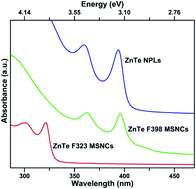Atomically thin heavy-metal-free ZnTe nanoplatelets formed from magic-size nanoclusters†
Abstract
Atomically thin colloidal quasi-two-dimensional (2D) semiconductor nanoplatelets (NPLs) have attracted tremendous attention due to their excellent properties and stimulating applications. Although some advances have been achieved in Cd- and Pb-based semiconductor NPLs, research into heavy-metal-free NPLs has been reported less due to the difficulties in the synthesis and the knowledge gap in the understanding of the growth mechanism. Herein wurtzite ZnTe NPLs with an atomic thickness of about 1.5 nm have been successfully synthesized by using Superhydride (LiEt3BH) reduced tributylphosphine–Te (TBP-Te) as the tellurium precursor. Mechanistic studies, both experimentally and theoretically, elucidate the transformation from metastable ZnTe MSC-323 magic-size nanoclusters (MSCs) to metastable ZnTe MSC-398, which then forms wurtzite ZnTe NPLs via an oriented attachment mechanism along the [100] and [002] directions of the wurtzite structure. This work not only provides insightful views into the growth mechanism of 2D NPLs but also opens an avenue for their applications in optoelectronics.



 Please wait while we load your content...
Please wait while we load your content...